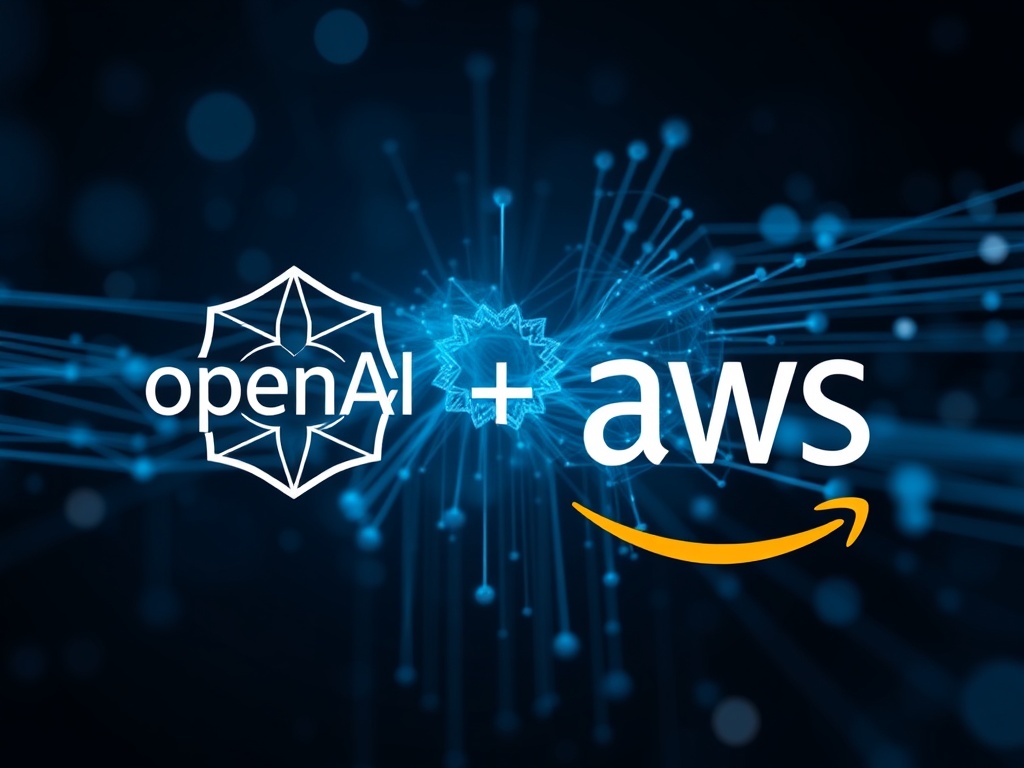BitcoinWorld

Unprecedented OpenAI AWS Partnership: A Game-Changer for Cloud AI
In the dynamic world of technology, where every partnership can redefine market landscapes, a truly significant development has emerged. For the first time, OpenAI’s powerful models are now available on Amazon Web Services (AWS), marking a pivotal moment in the evolution of artificial intelligence and cloud computing. This collaboration isn’t just a technical integration; it’s a strategic alliance poised to reshape the competitive terrain of cloud AI and democratize access to cutting-edge AI models for businesses worldwide. For those in the cryptocurrency and blockchain space, understanding the foundational shifts in AI infrastructure is crucial, as these technologies increasingly intersect.
The Unprecedented OpenAI AWS Partnership: A New Era for AI Models
The announcement that OpenAI, led by Sam Altman, is bringing its sophisticated models to AWS is nothing short of a strategic masterstroke. Historically, Microsoft Azure has been OpenAI’s primary cloud partner, fostering a close relationship that has significantly influenced the generative AI landscape. However, this new collaboration with AWS signals a deliberate expansion of OpenAI’s reach and a clear intent to diversify its cloud alliances. Specifically, OpenAI’s two new open-weight reasoning models, known for capabilities on par with its flagship o-series, will soon be accessible as a service on AWS. This isn’t merely AWS independently offering these models, which are available for download via Hugging Face; it’s a direct partnership, as confirmed by Dmitry Pimenov, OpenAI’s product lead for these models. This move dramatically changes the game, making these advanced AI models a direct choice for Amazon’s robust cloud AI services like AWS Bedrock and SageMaker AI. It’s a clear indication that OpenAI is looking to broaden its ecosystem, ensuring its innovations are accessible across multiple major cloud platforms.
Reshaping the Cloud AI Landscape: AWS’s Strategic Advantage
For Amazon Web Services, this partnership represents a significant competitive leap. Until now, AWS has been largely recognized as a major host and financial backer for Anthropic’s Claude, a primary competitor to OpenAI. While AWS already offers a diverse portfolio of models from various makers—including Cohere, DeepSeek, Meta, and Mistral, alongside its own proprietary solutions—the inclusion of OpenAI’s models elevates its standing considerably. This development finally places the cloud giant firmly in the conversation with the biggest name in AI model development, OpenAI. This is especially critical given the intense scrutiny AWS has faced regarding its position in the rapidly evolving cloud AI market. Amazon CEO Andy Jassy has openly acknowledged the competitive pressures, particularly from Microsoft. During recent quarterly earnings calls, Jassy faced pointed questions from Wall Street analysts about AWS potentially losing ground in AI. For instance, JPMorgan analyst Doug Anmuth inquired about the ‘significantly faster cloud growth among the number two and number three players in the space,’ referring to Microsoft and Google. Morgan Stanley analyst Brian Nowak echoed these concerns, stating that Wall Street perceived AWS as ‘falling behind in GenAI with concerns about share loss, peers, etc.’ Jassy’s spirited defense, emphasizing AWS’s market leadership by stating ‘the second player is about 65% of the size of the AWS,’ underscores the intensity of this competition. By partnering with OpenAI, AWS directly addresses these concerns, offering its customers a wider, more compelling array of AI models for their applications, especially through platforms like AWS Bedrock.
Unlocking Generative AI Potential: Benefits for Enterprises
The integration of OpenAI’s models into AWS’s ecosystem brings immediate and substantial benefits for enterprises. AWS customers utilizing services like AWS Bedrock, designed for building and hosting generative AI applications, will now have the flexibility to experiment with and deploy OpenAI’s cutting-edge models seamlessly. Similarly, SageMaker users, who train or build their own AI models largely for analytics, gain new powerful tools at their disposal. This broadens the horizon for innovation, allowing businesses to leverage some of the most advanced AI capabilities available without having to manage complex integrations. From OpenAI’s perspective, this partnership is also a shrewd strategic maneuver. Its relationship with Microsoft, while foundational, is reportedly undergoing renegotiation, leading to some strain. By cozying up to the largest cloud provider, even if initially on a smaller scale compared to Azure, OpenAI strengthens its bargaining position and diversifies its infrastructure dependencies. Moreover, this move allows OpenAI to subtly undercut competitors like Meta. As OpenAI releases these two high-performing models under an Apache 2.0 open-source license, Meta recently admitted that it might not continue to open-source all of its upcoming ‘superintelligence’ models. This difference in approach could sway developers and enterprises looking for open and flexible solutions for their generative AI projects, further solidifying OpenAI’s market presence and expanding the reach of OpenAI AWS collaboration.
Navigating the Future of AI Models and Cloud Computing
The ripple effects of this partnership extend beyond just OpenAI and AWS. The broader landscape of cloud computing and AI development is undergoing a rapid transformation, driven by unprecedented demand for advanced capabilities. This strategic alignment underscores the fierce competition among cloud providers to offer the most comprehensive and powerful suite of AI models. It highlights a trend where leading AI developers are seeking to establish multi-cloud strategies, ensuring their innovations reach the widest possible audience while maintaining leverage over any single partner. The recent news of Oracle signing a colossal $30 billion-a-year deal with OpenAI for data center services further illustrates this point. This massive commitment suggests OpenAI is investing heavily in diversifying its infrastructure, ensuring resilience and scalability across various providers, not just Microsoft. For enterprises, this evolving landscape means greater choice and flexibility. Businesses are no longer locked into a single vendor’s AI stack but can select the best-of-breed models and services across different cloud platforms. This competition is ultimately beneficial for end-users, driving down costs, accelerating innovation, and pushing the boundaries of what’s possible with artificial intelligence. The availability of OpenAI’s models on AWS will undoubtedly spur new applications and use cases across industries, from healthcare to finance, entertainment, and beyond, significantly impacting the future of cloud AI.
The collaboration between OpenAI and AWS marks a significant milestone in the AI revolution. It’s a strategic alliance that benefits both parties: OpenAI gains broader access to enterprise customers and strengthens its negotiating position, while AWS enhances its competitive standing in the crucial cloud AI market. This partnership not only diversifies the availability of cutting-edge AI models but also intensifies the competition among cloud providers, ultimately fostering a more dynamic and innovative ecosystem. As artificial intelligence continues its rapid advancement, such strategic alignments will be key to shaping its future direction, offering businesses unprecedented opportunities to harness the power of generative AI for transformative growth. This is a clear signal that the future of AI is increasingly multi-cloud and highly competitive, promising exciting developments for years to come.
To learn more about the latest AI Models trends, explore our article on key developments shaping AI features.
This post Unprecedented OpenAI AWS Partnership: A Game-Changer for Cloud AI first appeared on BitcoinWorld and is written by Editorial Team





